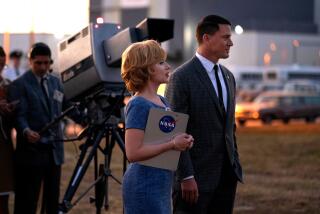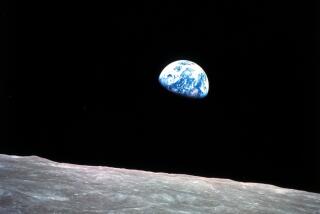Our place in the universe
- Share via
Since the birth of movies, the moon has exerted a fascination as a mythic location. In 1902, the cinema’s original magician, Georges Melies, used a projectile cannon, cardboard sets and a host of camera tricks to imagine “A Trip to the Moon.” Fritz Lang’s final silent film, “Woman in the Moon” (1929), also envisioned a fanciful lunar expedition and in the process apparently invented the blast-off countdown. Just this year, director Duncan Jones used the evocatively barren moonscape as the setting for his eerie little existential drama, “Moon.”
Compared to these sci-fi fantasies -- and even alongside other nonfiction films about the moon and space travel -- Al Reinert’s 1989 documentary “For All Mankind” has the obvious edge of immediacy. The film consists simply of footage shot by the astronauts who took part in the Apollo program, interspersed with occasional scenes at NASA’s mission control center in Houston.
First released to mark the 20th anniversary of the July 1969 moon landing, “For All Mankind” now is being reissued Tuesday on DVD by the Criterion Collection, in standard-definition and Blu-Ray editions, on the occasion of the 40th anniversary.
The Apollo program began in 1961, the year President Kennedy, in a speech to Congress, issued a challenge to America to land a man on the moon in that decade. Between 1968 and 1972, NASA launched nine manned flights to the moon; in all, 24 men were sent into space, 12 of whom set foot on the moon.
Splicing together scenes from the various missions (without ever identifying the source of the footage), Reinert creates a single composite odyssey. The narration, pieced together from recordings of and interviews with unidentified astronauts, likewise conjures the effect of a faceless but universal hero, who is, as one of the men puts it, “the representative of humanity.”
A Texas journalist making his first film, Reinert takes a self-effacing tack, favoring the astronauts’ point of view and allowing them to speak for themselves. But “For All Mankind” is nonetheless a remarkable feat of assemblage: Reinert combed through thousands of hours of archival footage from the NASA vaults -- the men were armed with 16-millimeter data acquisition cameras -- and conducted many more hours of his own interviews.
The trip follows an arc familiar from countless fantastic voyages, from liftoff to landing to splashdown. In between, there are stretches of weightless downtime as the men prepare meals, listen to the tapes they brought with them (Merle Haggard and Buck Owens), and even get into a (mercifully brief) discussion about zero-gravity defecation.
There is also the requisite awe and wonder at the out-of-this-world view as the Earth recedes and the moon approaches. Confronting an endless expanse of nothingness, one of the men waxes philosophical, pondering the meaning of infinity. But thanks in part to Brian Eno’s hushed, haunting score, “Mankind” never succumbs to hokey or fuzzy grandeur; if anything, the film maintains a low-key simmer that is a pleasant change from the triumphalist cliches of most spaceflight narratives.
Reinert interviewed most of the men in the late 1970s, by which point they were retired and recounting their adventures with the benefit of perspective, which presumably accounts for the wistfully reflective tone.
The Criterion disc includes a wealth of extras: a making-of documentary that reveals how the footage was shot, additional interviews with 15 Apollo astronauts, a gallery of moonscape paintings by astronaut- turned-artist Alan Bean.
“For All Mankind” earned a feature documentary Oscar nomination; Reinert went on to co-write the screenplay for Ron Howard’s “Apollo 13.” There are other accounts of the Apollo missions, such as the HBO miniseries “From the Earth to the Moon” and the recent documentary “In the Shadow of the Moon,” that are both more straightforward and more informative.
But in striving for a kind of cosmic poetry, in privileging sensory experience above all else, “For All Mankind” remains a one-of-a-kind artifact.
--
More to Read
Only good movies
Get the Indie Focus newsletter, Mark Olsen's weekly guide to the world of cinema.
You may occasionally receive promotional content from the Los Angeles Times.










